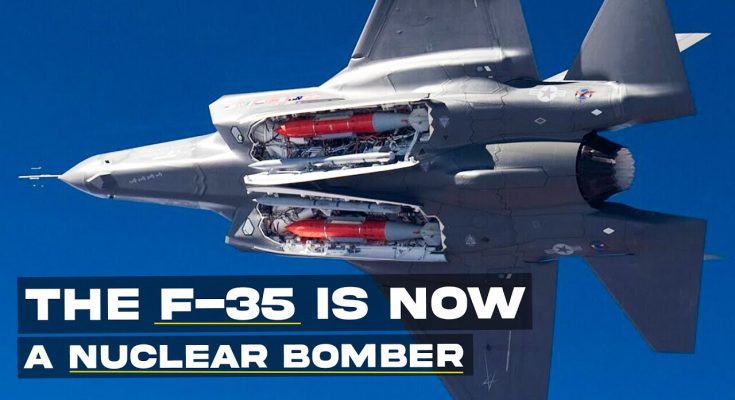The F-35 is Now a Nuclear Bomber
The F-35 Lightning II has long been known for its versatility and advanced capabilities in a variety of combat roles. Initially conceived as a multirole stealth fighter, the F-35 has evolved over time to incorporate nuclear strike capabilities, making it an even more significant asset in the U.S. and NATO arsenals. With its stealth features, advanced avionics, and multirole flexibility, the F-35 is now officially recognized as a nuclear bomber, a critical component of modern deterrence strategy.
F-35: A Multirole Masterpiece
The F-35 is designed to be a multirole aircraft capable of executing a broad range of missions, from air superiority and close air support to intelligence gathering and precision strikes. With variants suited for different environments—the F-35A for the U.S. Air Force, the F-35B for the Marine Corps, and the F-35C for the Navy—the F-35 can operate from land bases, aircraft carriers, and amphibious assault ships. Its stealth capabilities, advanced sensors, and networked systems enable it to carry out complex missions in contested airspace, making it one of the most advanced fighter jets in the world.
The Evolution to a Nuclear Role
While the F-35 has always been designed with versatility in mind, its transition into a nuclear-capable aircraft marks a significant shift in its role. In recent years, the F-35 has been integrated into the U.S. nuclear deterrence strategy, specifically in the role of a nuclear bomber. In 2022, the U.S. Air Force officially declared the F-35A as certified to carry the B61 nuclear bomb, a low-yield nuclear weapon designed for strategic and tactical purposes.
The decision to add the F-35 to the list of nuclear-capable aircraft alongside the B-2 Spirit and B-52 Stratofortress reflects a broader shift toward modernizing the U.S. nuclear deterrence triad, which includes land-based missiles, submarine-launched missiles, and strategic bombers. The F-35’s integration into this role enhances the U.S. Air Force’s ability to conduct nuclear strike missions while maintaining a flexible, stealthy, and precise platform for this critical deterrence mission.
The B61 and F-35: A Perfect Match
The B61 nuclear bomb is a family of modular, versatile weapons that can be used for a variety of missions, ranging from low-yield tactical strikes to larger strategic attacks. The weapon can be fitted with different modifications to allow for adjustable yield levels, providing a degree of flexibility for commanders.
When paired with the F-35A, the B61 bomb represents a modern nuclear option with improved precision and reliability. The F-35’s advanced avionics, targeting systems, and stealth technology make it an ideal platform for delivering the B61 with pinpoint accuracy while avoiding detection by enemy air defenses. The F-35’s ability to penetrate contested airspace without being detected gives it a strategic advantage over older aircraft that lack such advanced stealth capabilities.
A New Deterrence Capability
The addition of nuclear capabilities to the F-35 enhances its role within the broader framework of nuclear deterrence. By integrating the F-35 into the nuclear triad, the U.S. now has more options for nuclear retaliation, allowing for greater flexibility and redundancy in its deterrence posture. This capability is particularly important in a world where nuclear proliferation is a growing concern, and adversaries may possess advanced air defense systems that threaten traditional bombers.
Moreover, the F-35’s ability to carry nuclear weapons while also being able to perform conventional strike missions makes it a highly adaptable tool in both nuclear and conventional warfare. It offers strategic ambiguity, meaning adversaries may find it harder to determine whether an F-35 is carrying conventional or nuclear payloads, making it a more effective deterrent.
Global Implications
NATO allies also benefit from the F-35’s nuclear capability. As part of NATO’s nuclear-sharing arrangements, countries like Germany, Italy, and the Netherlands are set to receive F-35s equipped for nuclear missions. This enhances NATO’s nuclear deterrence capabilities and ensures that allied nations remain aligned with the U.S. in upholding global security and peace.
Conclusion
The F-35’s evolution into a nuclear bomber underscores its importance as a multirole, multigenerational platform for both conventional and nuclear operations. Its stealth, flexibility, and advanced systems allow it to perform diverse roles, from air-to-air combat to precision strikes and now nuclear deterrence. As the U.S. and its allies face emerging threats, the F-35’s role as a nuclear-capable aircraft ensures that it will remain a key asset for years to come in maintaining peace through strength.



